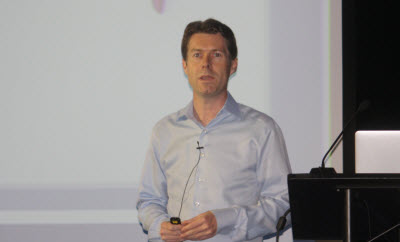
Just ask Gareth Davis, a platform manager at Facebook, who has seen thousands of social games come and go.
[aditude-amp id="flyingcarpet" targeting='{"env":"staging","page_type":"article","post_id":310991,"post_type":"story","post_chan":"none","tags":null,"ai":false,"category":"none","all_categories":"business,dev,games,social,","session":"A"}']If game companies pay attention to the advice, they just might have a chance to challenge the social game industry’s leader, Zynga.
Davis, speaking at the Casual Connect game conference in Seattle, said that there are 200 million monthly active users on Facebook and that the average length per game session is 55 minutes. Facebook is trying to move those players over to mobile platforms such as Android or the iPhone. Zynga has more than 266 million monthly active users on Facebook, but it’s in Facebook’s interest to diversify that and encourage more game companies to make social games.
AI Weekly
The must-read newsletter for AI and Big Data industry written by Khari Johnson, Kyle Wiggers, and Seth Colaner.
Included with VentureBeat Insider and VentureBeat VIP memberships.
“My belief is that you can do good social design by taking the collective learnings of people on the platform,” Davis said.
Here are Davis’ tips on how to create the best social games.
1. Start with social from the ground up. Don’t adapt games from older ways of building games. That means it must be easy for gamers to share what they can achieve in the game with their friends. Those players have to be engaged long enough so they can interact with their friends and help the game spread.
2. Optimize for social discovery and distribution. Discovery is a huge problem, but Facebook itself has a lot of different ways to spread news about games, from the news feed to email messages.
3. Focus on engagement. If they don’t come back, it doesn’t matter.
4. Make sure you take advantage of retail-level merchandising of virtual goods. Virtual goods are the primary means of making money in free-to-play social games. Users play for free but pay real money for virtual goods. Merchandising means you should offer discounts or sales to users on a regular basis. And you should target certain virtual goods toward “whales,” or social gamers who will pay lots of money to climb to the top of the leaderboards in a game.
[aditude-amp id="medium1" targeting='{"env":"staging","page_type":"article","post_id":310991,"post_type":"story","post_chan":"none","tags":null,"ai":false,"category":"none","all_categories":"business,dev,games,social,","session":"A"}']
5. Use analytics for business intelligence. Good analytics allows for insight into the way customers think and lets you figure out what to sell to them.
6. Use interactive development with A/B testing. A/B testing is where you test two different ideas and se which one will be more popular with users. It’s a scientific approach to game development and is a critical part of the feedback cycle in social games.
7. Deploy globally on multiple platforms. Game developers should strive to reach a worldwide audience and support multiple ways to reach an audience. Developers can, for instance, create HTML5 games that are cross-platform titles, but they can also create native apps, or those that take advantage of a particular platform. By pursuing gamers in all markets, social game developers can hit the biggest audience.
VentureBeat's mission is to be a digital town square for technical decision-makers to gain knowledge about transformative enterprise technology and transact. Learn More
